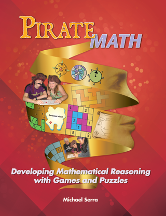Pirate Math will delight those who enjoy challenging math puzzles and games. Author Michael Serra recommends Pirate Math for students in grades 5 thhrough 12, but adults might love playing or puzzling as well. I think the book is probably ideal for grades seven and up, since those students will already be prepared with more of the mathematical knowledge they will need for the activities.
Some activities can be done independently, but some require or work better with two or more students working together either cooperatively or competitively. These activities should work especially well with class groups. However, I can also envision older, self-motivated students who will tackle this book all by themselves without assistance or competition.
There are more than 450 games and puzzles. The sequence is important. The first topic Serra introduces is polyominoes: “shapes made by connecting congruent squares complete side to complete side” (p. 1). Note that polyominoes do not need to be constructed in straight lines! Once students are familiar with polyominoes, they will find themselves hunting for polyominoes in many of the treasure map games they will encounter later in the book.
Lessons sometimes begin with something that looks deceptively easy. Then Serra introduces numerous complexities and challenges built upon that concept. For example, activities with polyominoes gradually become more complex. Students begin simply by constructing possible pentominoes. But page 12 has them complete a hexomino sudoku puzzle, a six-by-six square made up of six oddly shaped hexominoes. “Every row, column, and hexomino region must contain the numerals 1-6."
Numerous mathematical and logic skills come into play throughout the book, skills such as patterns, graphing and coordinate points, transformations, translation vectors, and geometric constructions.
The bulk of the book presents variations on buried treasure games. However, each chapter requires application of a particular type of math skill. Chapters 2 and 3 use the Cartesian Coordinate Plane and the Polar Coordinate Plane, respectively, as students work on their hunts for buried treasure. In Chapter 4, latitude and longitude lines on spherical surfaces come into play. Chapter 5 uses 3-D coordinates, and Chapter 6 requires students to use logic along with geometric constructions. Chapter 7 first teaches about cryptography then has students apply their skills to decipher messages for yet another hunt.
Some game sheets in the book offer simpler and more challenging puzzles. Students should generally start with the simpler and progress as they master each one. Struggling students might not complete all of them.
Serra teaches as he goes although Pirate Math is intended as a supplement rather than a math course. For example, he begins Chapter 3 explaining the Polar Coordinate System, after which he presents a sample problem and its solution. This is followed by ten application problems for practice. In Chapter 6, Serra first covers basic geometric constructions with a compass, straightedge, ruler, and protractor. He also teaches triangle congruency shortcuts and points of concurrency, all of which students need to know to complete their treasure hunts. In this case, there are no practice problems.
The extensive appendices include games sheets, hints, and an answer key. You will likely find the hints very helpful from time to time, but discourage students from using the hints unless they really need to. One of Serra’s goals with this book is to encourage students to persevere in problem solving, so short-cutting to the hints prevents them learning perseverance.
Each student should have his or her own book since they will write directly in the book. Pages are not meant to be reproduced for class groups. It seems to me that students will very likely need to refer back to previous chapters occasionally, so they need the entire book available to them. However, there is a note on Michael Serra’s website that says: “If you purchase directly from our website, we will also email you an electronic file of BW pdf worksheets for classroom use.” Given the cost of the book, I would recommend that homeschoolers do this rather than purchasing multiple books, then make the “parent” copy of the book available for student reference as needed.
Parents and teachers will likely want to spend some time familiarizing themselves with Pirate Math before presenting it to students. This is not an open-and-go resource! But the Aha! moments you and your students are likely to experience should make it well worth the time investment.









